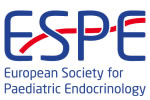hrp0095p1-261 | Diabetes and Insulin | ESPE2022
Parental stress in children with type 1 diabetes from different socioeconomic backgrounds
Levy-Khademi Floris , Heifetz Eliyahu , Avnon-Ziv Carmit , Auerbach Adi , Birnbaum Hanna
hrp0092p3-211 | Pituitary, Neuroendocrinology and Puberty | ESPE2019
Peculiarities of Clinical Options for Delaying Sexual Aging in Boys-Adolescents
hrp0095fc2.6 | Bone, Growth Plate and Mineral Metabolism | ESPE2022
Pseudohypoparathyroidism Type 1A (PHP1A): Growth patterns under growth hormone therapy for short stature
Ertl Diana-Alexandra , Mantovani Giovanna , Perez de Nanclares Guiomar , Gleiss Andreas , Hanna Patrick , Marta Elli Francesca , Pereda Arrate , Rothenbuhler Anya , Audrain Christelle , Berkenou Jugurtha , Linglart Agnes
hrp0089p1-p218 | Sex Differentiation, Gonads and Gynaecology or Sex Endocrinology P1 | ESPE2018
Primary Gonadal Dysgenesis in Male 46,XY Patients with NR5A1 Variants Predominantly Affects Sertoli Cell Function
Hoppmann Julia , Werner Ralf , Lunstedt Ralf , Birnbaum Wiebke , Schwab Otfried , Marshall Louise , Wunsch Lutz , Hiort Olaf
hrp0095p2-126 | Fat, Metabolism and Obesity | ESPE2022
Vitamin D, OPG in Obese Children
Mikhno Hanna , Solntsava Anzhalika
hrp0084p1-136 | Turner & Puberty | ESPE2015
The Eap1 Promoter is Differentially Methylated at the Onset of Puberty in Normal Weight and Obese Female Rats
hrp0094p2-194 | Fat, metabolism and obesity | ESPE2021
Vitamin D deficiency in obese children
Mikhno Hanna , Solntsava Anzhalika ,
hrp0097p2-70 | Fat, Metabolism and Obesity | ESPE2023
Association of osteoprotegerin and metabolic status in obese children.
Mikhno Hanna , Solntsava Anzhalika
hrp0092p2-111 | Fat, Metabolism and Obesity | ESPE2019
Osteoprotegerin and Metabolic Status in Children with Obesity
Mikhno Hanna , Solntsava Anzhalika , Dashkevich Helena
hrp0089p3-p137 | Fat, Metabolism and Obesity P3 | ESPE2018
The Level of the Vitamin D and Metabolic Status in Children with Obesity
Mikhno Hanna , Solntsava Anzhalika , Dashkevich Helena



